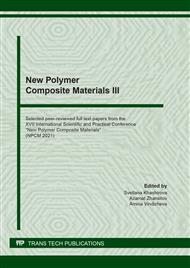p.202
p.208
p.215
p.220
p.226
p.232
p.239
p.245
p.253
Anionic Copolymerization of Acrylonitrile with Ethyl Acrylate under the Action of the Initiating System of 1,4-Diazabicyclo[2.2.2]Octane – Ethylene Oxide
Abstract:
It was found, studying acrylonitrile copolymerization with ethyl acrylate in dimethyl sulfoxide under the action of anionic initiating system of 1,4-diazabicyclo [2.2.2] octane – ethylene oxide, that the obtained copolymers have a branched structure. An increase in the molar fraction of ethyl acrylate in the reaction medium leads to a decrease in the initial rate of acrylonitrile polymerization. Thermal behavior of copolymer samples was investigated; it was found that ethyl acrylate, being introduced into the polyacrylonitrile structure, both reduces thermal effects related to the reactions taking place during heat treatment of copolymers, and increases the half-width of the heat release peak.
Info:
Periodical:
Pages:
226-231
Citation:
Online since:
September 2021
Price:
Сopyright:
© 2021 Trans Tech Publications Ltd. All Rights Reserved
Share:
Citation:


